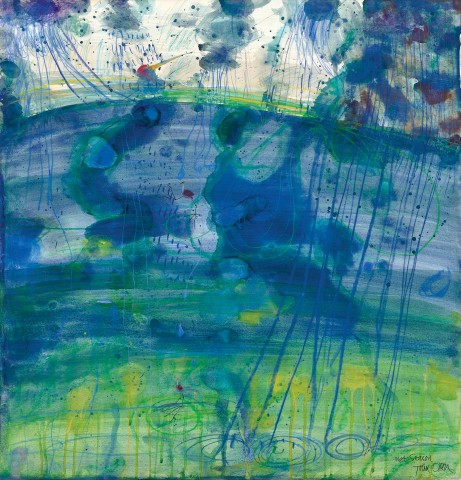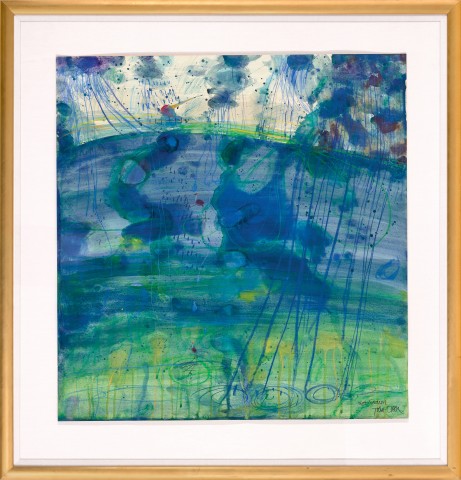WET SEASON
JOHN OLSEN
watercolour and pastel on paper
98.5 x 95.0 cm
signed and inscribed with title lower right: Wet Season / John Olsen
Greenhill Galleries, Perth
Private collection, Perth, acquired from the above in the late 1980s
We are grateful to Kylie Norton, Editor, John Olsen Catalogue Raisonné, for her assistance with this catalogue entry.
With his distinctive meandering line, exuberant mark-making and mastery of colour, John Olsen is universally revered as one of the most important artists in a generation that defined the way Australia perceived its natural environment. Throughout his vast career spanning more than seven decades, he revealed an unerring fascination with the natural world in all its myriad forms, creating evocative depictions of the landscape that arguably capture the spirit and character of this country more eloquently than any other non-indigenous artist before him. From the pulsating energy of his You Beaut Country series, to the quieter, more metaphysical paintings inspired by his expeditions to Lake Eyre, or the exquisitely lyrical works immortalising his halcyon days in Clarendon, his signature technique fusing painting and drawing as one reveals the hand and eye of the artist with every stroke – the act of creation thus imbuing the painted surface with a powerful sense of the artist’s own exuberant energy and palpable joie de vivre. As Deborah Hart, curator and author of several authoritative publications on the artist, asserts, ‘Olsen has confronted and helped redefine our basic conception of landscape… providing a psychological encounter with place, not only as seen but as experienced, resulting in a fresh, exhilarating vision.’1
A superb example of Olsen’s talent as a ‘master watercolourist’, Wet Season tangibly attests to the artist’s exceptional ability to create atmosphere, to embody the sight as well as feel of his subject – in this instance, the dampness and humidity accompanying a deluge of tropical abundance. Here thunderclouds full of life-giving rain are reflected in the transparent waters below, with both upper and lower parts of the composition further united by the runs of blue and green paint down the picture plane, thus tangibly evoking memories of water running down the windowpane on a wet day. Amidst dark areas of wash, deft lines of pastel provide stable touches and delineate the various bird species which sport with playful abandon in the downpour. Watercolour is the ideal medium, its fluidity and adroit execution capturing brilliantly the sensations of the moment; the work not only looks wet, it feels wet.
Resonating with a vitalistic energy, indeed the work betrays a sense of not only keen observation, but joyful celebration derived from a lifetime dedicated to physical and spiritual immersion in the landscape. For ultimately, as Olsen poignantly mused, the Australian outback offered more than mere topographical phenomena to be accurately recorded. More fundamentally, the experience was the catalyst for a myriad or ideas and metaphorical connections that reaffirmed his Taoist belief in the total interconnectedness of all living forms, thereby heralding a new spirituality in his art: ‘The enigma of it all. It is a desert and it can be full. After the rains, it is so incredibly abundant; so what you are looking at in one place, as if through an act of the Dao, becomes full… It has an effect on you when you are there because all the time it is impossible for you to accept fully the sense of impermanence and transitoriness… Somehow it affects you – you realise that you are looking at an illusion really. I don't think that there is anything more Buddhist than that.’2
1. Hart, D., John Olsen, Craftsman House, Sydney, 2000, p. 207
2. Olsen, cited in Hart, ibid., p. 135
VERONICA ANGELATOS


